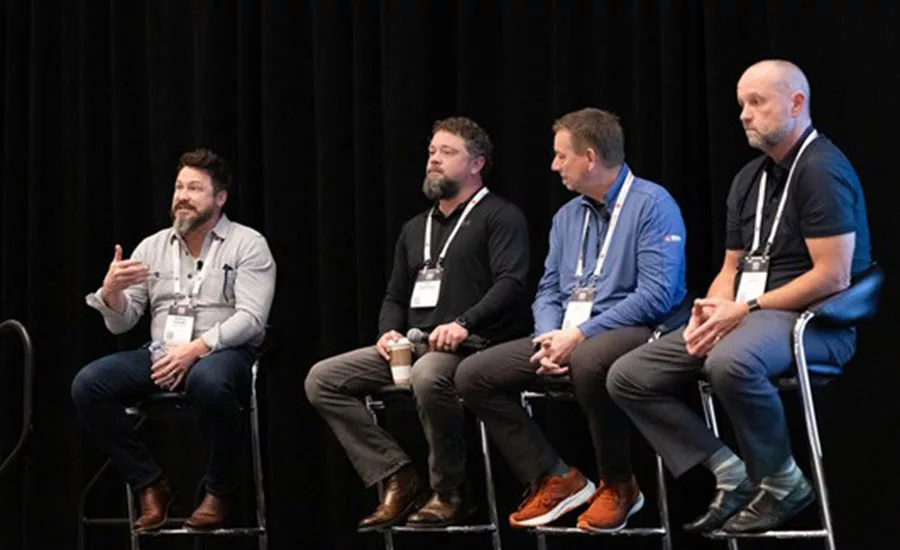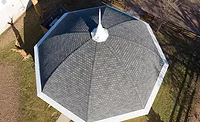Self-Adhering Bituminous Roofing Membranes
The ancient Mesopotamians had it right when they began using asphalt to waterproof temple baths and water tanks. The Phoenicians later found asphalt useful in caulking the seams of their merchant ships. And when they needed to seal their baths, reservoirs, and aqueducts, guess what substance the Romans relied on? Thousands of years later, asphalt has a proven track record documenting its ability to resist water penetration.

The ancient Mesopotamians had it right when they began using asphalt to waterproof temple baths and water tanks. The Phoenicians later found asphalt useful in caulking the seams of their merchant ships. And when they needed to seal their baths, reservoirs, and aqueducts, guess what substance the Romans relied on? Thousands of years later, asphalt has a proven track record documenting its ability to resist water penetration.
The premise has remained the same, but the technology has changed. In the past decade, major advances have been made in asphalt roofing. Modified bituminous roof membranes, for example, have emerged as a popular option for low-sloped roofs.
Asphalt used in manufacturing modified bitumen systems is generally modified with one of two materials: atactic polypropylene (APP) or styrene butadiene styrene (SBS). These modifiers create a uniform matrix that enhances the physical properties of the asphalt.
When added to asphalt, APP gives the substance plastic properties, creating greater elasticity and stretching the modified asphalt. Likewise, the SBS polymer soaks up asphalt like a sponge, fixes its shape and form, and imparts flexibility and resilience to the membrane. Thus, the membrane is self-sealing around nails.
SBS-modified bitumen membranes resist water penetration while exhibiting superior elongation and recovery properties over a wide range of temperature extremes. This high-performance benefit makes them exceptionally durable, reliable and easy to maintain.
Constructed in a similar fashion to traditional modified bituminous materials, self-adhesive compounds comprise asphalt, polymers and fillers. Additionally, certain resins may be added to improve adhesion characteristics. The membranes are reinforced with fiberglass, polyester or a combination of the two.
Among the advantages of self-adhesive membranes are safe and fast application through the use of highly engineered asphalts. Self-adhesive membranes also reduce the need for hot asphalt. In low-slope roofing, you can choose from a range of peel-and-stick self-adhesive products that have been used successfully on high-density, fume-sensitive occupancy type buildings such as health care facilities and schools.
Based on their growing popularity, there is an ASTM International standard written to address self-adhesive membranes installed beneath exposed roofing materials (ASTM D1970, "Standard Specification for Self-Adhering Polymer Modified Bituminous Sheet Materials Used as Steep Roofing Underlayment for Ice Dam Protection.") In addition, standards are currently being developed to address APP and SBS based self-adhesive membranes in both low-slope and steep-slope applications.
Typically, these membranes are installed from the eaves edge to a point at least 24 inches inside the exterior wall line of the building, beneath the finished shingle layers. The adhesive asphalt component effectively seals the membrane to itself, and around the shanks of nails used in overlying shingles, so that any water that is forced underneath the shingle layers by wind or ice dams does not reach the deck or attic space below.
Self-adhesive underlayment membranes can also be used as part of a flashing system in valleys or around roof penetrations (skylights, vent stacks, etc.), and are commonly applied beneath roofing materials on lower sloped roofs (2:12 to 4:12).
In lower-sloped residential roofs (2:12 to 4:12), homeowners and roofing contractors can also apply the underlayment membrane over the entire roof area, to protect the roof should water get underneath the shingle layer. Some self-adhering membranes are actually designed to be applied as exposed roof coverings, and are covered with colored granules, similar to asphalt shingles. When installed, these membranes form a strong vapor seal over the attic.
Some builders have found this type of membrane to be so durable that it can remain exposed on the roof longer than other membranes (in some cases days or even weeks), allowing them time to get back to the job at hand.
Whether the membrane is exposed or not, moist air entering the attic from the heated living space below can be trapped beneath the membrane-covered roof deck and condense. Serious problems such as wood rot, mold development and water staining can occur.
To avoid condensation problems, the Asphalt Roofing Manufacturers Association (ARMA) recommends installing sufficient insulation, covering the entire attic floor to reduce heat migration into the attic. Homeowners and contractors should consider installing a continuous vapor retarder on the floor of the attic, beneath the insulation. Adequate through-ventilation should be installed to ensure sufficient airflow through the attic cavity.

In this residential application, LeakBarrier MS300 Ice and Water Armor from Tarco is used to cover eaves and valleys where ice ice dams are most likely to occur. (Photo courtesy of Tarco.)
The ancient Mesopotamians had it right when they began using asphalt to waterproof temple baths and water tanks. The Phoenicians later found asphalt useful in caulking the seams of their merchant ships. And when they needed to seal their baths, reservoirs, and aqueducts, guess what substance the Romans relied on? Thousands of years later, asphalt has a proven track record documenting its ability to resist water penetration.
The premise has remained the same, but the technology has changed. In the past decade, major advances have been made in asphalt roofing. Modified bituminous roof membranes, for example, have emerged as a popular option for low-sloped roofs.
Asphalt used in manufacturing modified bitumen systems is generally modified with one of two materials: atactic polypropylene (APP) or styrene butadiene styrene (SBS). These modifiers create a uniform matrix that enhances the physical properties of the asphalt.
When added to asphalt, APP gives the substance plastic properties, creating greater elasticity and stretching the modified asphalt. Likewise, the SBS polymer soaks up asphalt like a sponge, fixes its shape and form, and imparts flexibility and resilience to the membrane. Thus, the membrane is self-sealing around nails.
SBS-modified bitumen membranes resist water penetration while exhibiting superior elongation and recovery properties over a wide range of temperature extremes. This high-performance benefit makes them exceptionally durable, reliable and easy to maintain.
Greatest of Ease
Add "versatile" to that list of attributes. Historically, modified bitumen membranes were torch-applied, mop-applied using hot asphalt or applied with solvent-based adhesives. Newer membranes combine the performance of proven modified bituminous compounds with a self-adhesive bituminous layer for ease of application.Constructed in a similar fashion to traditional modified bituminous materials, self-adhesive compounds comprise asphalt, polymers and fillers. Additionally, certain resins may be added to improve adhesion characteristics. The membranes are reinforced with fiberglass, polyester or a combination of the two.
Among the advantages of self-adhesive membranes are safe and fast application through the use of highly engineered asphalts. Self-adhesive membranes also reduce the need for hot asphalt. In low-slope roofing, you can choose from a range of peel-and-stick self-adhesive products that have been used successfully on high-density, fume-sensitive occupancy type buildings such as health care facilities and schools.
Based on their growing popularity, there is an ASTM International standard written to address self-adhesive membranes installed beneath exposed roofing materials (ASTM D1970, "Standard Specification for Self-Adhering Polymer Modified Bituminous Sheet Materials Used as Steep Roofing Underlayment for Ice Dam Protection.") In addition, standards are currently being developed to address APP and SBS based self-adhesive membranes in both low-slope and steep-slope applications.
Residential Appeal
Self-adhering bituminous membranes are used in sloped roofing (greater than 2:12) as an underlayment to help prevent water entry from ice dams at the eave areas of shingled roofs in cold climates. Contractors and homeowners should always check local building codes to confirm eave protection requirements.Typically, these membranes are installed from the eaves edge to a point at least 24 inches inside the exterior wall line of the building, beneath the finished shingle layers. The adhesive asphalt component effectively seals the membrane to itself, and around the shanks of nails used in overlying shingles, so that any water that is forced underneath the shingle layers by wind or ice dams does not reach the deck or attic space below.
Self-adhesive underlayment membranes can also be used as part of a flashing system in valleys or around roof penetrations (skylights, vent stacks, etc.), and are commonly applied beneath roofing materials on lower sloped roofs (2:12 to 4:12).
In lower-sloped residential roofs (2:12 to 4:12), homeowners and roofing contractors can also apply the underlayment membrane over the entire roof area, to protect the roof should water get underneath the shingle layer. Some self-adhering membranes are actually designed to be applied as exposed roof coverings, and are covered with colored granules, similar to asphalt shingles. When installed, these membranes form a strong vapor seal over the attic.
Some builders have found this type of membrane to be so durable that it can remain exposed on the roof longer than other membranes (in some cases days or even weeks), allowing them time to get back to the job at hand.
Whether the membrane is exposed or not, moist air entering the attic from the heated living space below can be trapped beneath the membrane-covered roof deck and condense. Serious problems such as wood rot, mold development and water staining can occur.
To avoid condensation problems, the Asphalt Roofing Manufacturers Association (ARMA) recommends installing sufficient insulation, covering the entire attic floor to reduce heat migration into the attic. Homeowners and contractors should consider installing a continuous vapor retarder on the floor of the attic, beneath the insulation. Adequate through-ventilation should be installed to ensure sufficient airflow through the attic cavity.
Basic Guidelines
Before specifying or installing a particular product, manufacturers’ application recommendations should be consulted. However, there are some considerations for the application of self-adhesive membranes:- Self-adhesive membranes are generally packaged and stored in cardboard boxes or are protected with opaque wrapping. Unprotected self-adhesive products should not be stored in direct sunlight since exposure to ultraviolet rays may affect the adhesive properties, especially on the outer convolutions of the roll. Membranes should not be used if they are not tacky to the touch.
- Make sure the roof has adequate slope and drainage.
- When used over decks with attic spaces, ensure that the installation of self-adhesive membrane does not prevent or interfere with the ventilation of the existing construction.
- At the time of installation, the air, product, and substrate temperatures should be at or above the minimum application temperature recommended by the manufacturer. Consult the manufacturer for guidelines for material storage and handling during cold weather application.
- The substrate must be free of any dust, dirt, oils, moisture or debris that could interfere with proper adhesion. Often the roof surface must be primed prior to membrane application. Primer type, application rate and drying time for the individual product must be considered.
- There is no liquid bituminous layer to fill all the surface irregularities. Consequently, proper application is essential, especially at all overlaps and T-joints. End laps on the mineral-surfaced sheets may need to be heat welded or sealed with compatible roofing mastics.
Looking for a reprint of this article?
From high-res PDFs to custom plaques, order your copy today!




